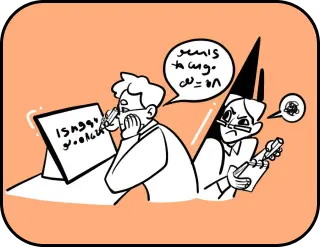Who are we trying to fool, time or ourselves? A look at digital immortality
“Your internet searches were so filthy we had to throw out your computer.”
(“The Office” TV series)
How do you like this? Every day you log into your browser, leaving a trace that becomes an immortal fingerprint, allowing you to be resurrected at any time.
We all leave such fingerprints when we enter our personal data on websites, follow links in search engines, write messages and do many ordinary actions on the Internet brought to the point of automation. Wendy H. Wong, the author of “We the Data: Human Rights in the Digital Age”, called such data sticky — like brushing your teeth twice a day, putting on contact lenses or moving from home to work.
After the death of the owner, digital property remains in the virtual space, which makes it possible to recreate the avatar of the deceased by those who own such technologies.

“When you have insomnia, everything is unreal; everything is so far away, a copy of a copy of a copy.”
(Chuck Palahniuk, “Fight Club”)
Let’s say you receive an avatar of a once real-life person. How old will this person be? How to reproduce the age-related development that he went through?
Perhaps as a child you kept personal diaries in the form of notes in notebooks, and then, after reading them again as an adult, you did not recognize yourself. And not everyone is happy to remember the past. For some, it is painful and they don’t want to keep it all in their memory.
Perhaps you have heard the phrase: “You will always be little to us”? And it was said precisely by those people who would like to remember your childhood and your digital avatar would be an excellent gift for them.
But! What to do with the fact that human behavior does not necessarily truthfully characterize its subject. Often we behave in a way that is appropriate in the social network in which we find ourselves and say what they want to hear from us. If a digital avatar is formed from its original that has undergone similar censorship (including self-censorship), then it becomes only a simulacrum of a person who did not exist in reality. Such treachery of the image will mislead anyone who is trying to establish a dialogue with this data set.

“If they’d the Philosopher’s Stone …”
(Johann Goethe, “Faust”)
The idea of reviving any person is not new, only technology changes. Let’s take a look at what the digital immortality industry now offers in the form of websites or apps.
“You take the blue pill, the story ends. You wake up in your bed and believe whatever you want to. You take the red pill, you stay in Wonderland…”
(“The Matrix” film)
The once fashionable film “The Matrix” popularly explained to the average person the difference between reality and its simulation. A conscious person is able to objectively perceive what is happening while a person living in illusions is not capable of that. A thought is a product of consciousness, which means it is found in those who possess this very consciousness. Having consciousness is a unique human quality that distinguishes us from other animals. This nuance makes it a problem to create an AI copy of a real-life person. If consciousness is in the brain, then we need to study all 100 trillion neural connections in the brain. But first, to decide how consciousness works because even this question does not have a clear answer. It turns out that a robot that has recreated a copy of someone is either a separate life form (without consciousness) or just a machine incapable to exist autonomously.
However, if a digital avatar is capable of reproducing a real person, then this image can be used to manipulate consciousness. Through the mouth of someone’s relative it can call for political action or thoughtless purchases. After all, what could be more desirable than being closer to someone you miss? – Their avatar speaks as if it was real, moves the same way and smiles. And so, when you come to the store, you buy the same clothes that were on your friend’s avatar, you buy soda, which “completely by accident” ended up in a generated photo with your friend. Without realizing what motivates you, you reach for these products in the store. This nuance of behavior can play a cruel joke on consumer behavior. Marketers dream of how to create advertising that will hit everyone’s pain points – and now we are on the verge of such an opportunity.
The idea of maximum human upgrade and loud expectations from robotization are actively spread by transhumanists. Dreams of immortality are utopian and illusory, but technologies that ensure immortality are completely penetrating our lives.
Will we be able to bring back the people who were once dear to us? Or will it be traces of search engine fingerprints?
Who are we trying to fool? Ourselves or time?

Scientists have decoded the human genome. We’ve decoded the genome of interest. Only pure science and facts.
Thank you!




